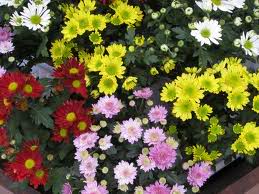Chrysanthemum is one of the leading cutflowers and potted plants in the international market. Domestic market has increased both for cutflowers and potted plants. Local production cannot cope with the demand, thus the importation of this cutflower from other countries.
The development of chrysanthemum industry as a major ornamental cutflower and potted plants enterprises supports the major thrusts of the government to develop the non-traditional export products that will boost the industry to earn dollars. The immediate benefits from chrysanthemum production will substitute the imported flowers with locally produced ones.
Orchids are grouped according to two basic growth habits, namely: monopodials and sympodials.

Chrysanthemum Cultivars
Selection of the cultivars depends on the purpose of the growers and the inherent characteristics of the cultivars to be used:
For cutflower production in the highlands
Golden Princess Anne
Bowl of Gold
Otome (White and Pink)
Taiwan Yellow
Taiwan White
For potted chrysanthemum:
Kikubiyori
Snowball
Genie
La France
Rhapsody
Red headline
Miss Hiroshima
Algiers
Capistrano
Autumn Fire
For lowland areas, the following cultivars have shown great performance:
Jean series – Jean red, Jean white and Jean yellow
Shin shong – Taiwan Yellow
kaingan – large yellow standard type
Sekaiteit – Taiwan Yellow
Cultural Management
Methods of propagation
Cuttings
Division/stolons
Seeds
Grafting
Tissue culture
Soil
Any soil that permits good drainage and aeration is suitable for chrysanthemum. A medium consisting of 1 part compost, 1 part garden soil and 1 part animal manure or the combination of compost and coir dust, or rice hull or garden soil can be used. A pH of 6.0 – 6.5 is recommended.
Temperature
The best temperature in growing chrysanthemum ranges from 20 – 28 °C for day and 15 – 20 °C for night.
Light intensity
Chrysanthemums are short day plant, which requires short days or long nights to flower. The critical day length is 14 – 15 hours for flower initiation and 13 -14 hours for development.
Planting
Rooted cuttings can be planted directly into raised beds or pots. Distance of planting varies according to the season. As more space per plant is allowed during those periods when light intensity is comparatively less.
The conventional spacing between the 1-meter wide beds is 15 x 15 cm during the dry season months and 15 x 20 cm during the wet season months
Water requirements
Chrysanthemum needs only small amount of water during the stages of growth but it is important to avoid water stress during the vegetative growth. Water requirement increases as vegetative growth progresses. However water requirement should be reduced as the plants approach the flowering stage.
Fertilizer requirements
Chrysanthemum takes up relatively large amount of both nitrogen and potassium during the vegetative growth. If the plants are already established, liquid fertilizers containing about 210 ppm N and 220 ppm potassium that should be added every 2 -3 weeks interval until buds show color.
Support/Staking
Since spray and standard chrysanthemums may be as tall as 30″ to 36″, it is necessary to support the stems as the crop matures. Generally, chrysanthemum are tied to bamboo stakes, metal hog wire or sturdy sticks to keep them erect and properly hold flowers or the main stem of the flowers.
Pinching and disbudding
Pinching on the growing tip of the plant is done to induce branching and increase the number of flowering stems per plant. Dis-budding for standard mums or “single flower” group. Lateral buds are removed to allow terminal bud to develop into a big flower. For spray types, the terminal bud is removed to develop a spray of large uniform flowers from lateral buds.
Harvesting
Spray mums are generally harvested at the two thirds to three-fourths open stage; standard mums at the three-fourths to full open stage of development. Flowers to be shipped long distances should be harvested when approximately one-half open. Flowers must be harvested late in the afternoon or early morning.
Pest Control
Aphids, thrips, leafminers and mites are the common insects attacking chrysanthemum. Spraying with any recommended insecticides may control the infestation. Cercospora leaf spot, alternaria leaf spot, fusarium stem rot and powdery mildew are the common diseases attacking chrysanthemums. Using any fungicide can control these diseases.
References
Bureau of Plant Industry Technoguides.
Source: bar.gov.ph

